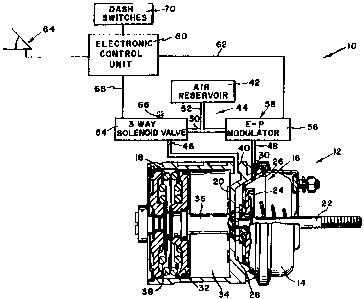Some of the information on this Web page has been provided by external sources. The Government of Canada is not responsible for the accuracy, reliability or currency of the information supplied by external sources. Users wishing to rely upon this information should consult directly with the source of the information. Content provided by external sources is not subject to official languages, privacy and accessibility requirements.
Any discrepancies in the text and image of the Claims and Abstract are due to differing posting times. Text of the Claims and Abstract are posted:
| (12) Patent: | (11) CA 2100684 |
|---|---|
| (54) English Title: | ELECTRO-PNEUMATIC SPRING AND SERVICE BRAKE ACTUATOR |
| (54) French Title: | COMMANDE DE FREIN ELECTRO-PNEUMATIQUE |
| Status: | Expired and beyond the Period of Reversal |
| (51) International Patent Classification (IPC): |
|
|---|---|
| (72) Inventors : |
|
| (73) Owners : |
|
| (71) Applicants : |
|
| (74) Agent: | MACRAE & CO. |
| (74) Associate agent: | |
| (45) Issued: | 2001-09-04 |
| (86) PCT Filing Date: | 1991-06-13 |
| (87) Open to Public Inspection: | 1992-08-06 |
| Examination requested: | 1998-04-17 |
| Availability of licence: | N/A |
| Dedicated to the Public: | N/A |
| (25) Language of filing: | English |
| Patent Cooperation Treaty (PCT): | Yes |
|---|---|
| (86) PCT Filing Number: | PCT/US1991/004229 |
| (87) International Publication Number: | WO 1992012879 |
| (85) National Entry: | 1993-07-15 |
| (30) Application Priority Data: | ||||||
|---|---|---|---|---|---|---|
|
An electro-pneumatic braking system includes a tandem brake actuator (12)
including a service brake actuating section (16)
and an emergency/parking spring actuated section (18). Hold-off pressure is
communicated to the emergency/parking section
through a three-way solenoid valve (54) from a pressure reservoir (42), and
communication to the service actuator is controlled by
electro-pneumatic modulator (56). Service pressure is taken both from the
branch of the conduit communicating with the air reser-
voir (42), but also from the hold-off pressure in the emergency/parking
reservoir (34). Accordingly, only a single line communi-
cates fluid pressure from the reservoir to the brake, and service brake
response; time is improved because the hold-off pressure
and the emergency/parking section of the actuator is used as a small reservoir
immediately adjacent the service actuator.
Note: Claims are shown in the official language in which they were submitted.
Note: Descriptions are shown in the official language in which they were submitted.

2024-08-01:As part of the Next Generation Patents (NGP) transition, the Canadian Patents Database (CPD) now contains a more detailed Event History, which replicates the Event Log of our new back-office solution.
Please note that "Inactive:" events refers to events no longer in use in our new back-office solution.
For a clearer understanding of the status of the application/patent presented on this page, the site Disclaimer , as well as the definitions for Patent , Event History , Maintenance Fee and Payment History should be consulted.
| Description | Date |
|---|---|
| Time Limit for Reversal Expired | 2006-06-13 |
| Letter Sent | 2005-06-13 |
| Inactive: Late MF processed | 2003-07-21 |
| Letter Sent | 2003-06-13 |
| Letter Sent | 2002-07-29 |
| Grant by Issuance | 2001-09-04 |
| Inactive: Cover page published | 2001-09-03 |
| Inactive: Final fee received | 2001-05-31 |
| Pre-grant | 2001-05-31 |
| Inactive: Office letter | 2001-05-30 |
| Inactive: Multiple transfers | 2001-04-20 |
| Letter Sent | 2001-03-19 |
| Notice of Allowance is Issued | 2001-03-19 |
| Notice of Allowance is Issued | 2001-03-19 |
| Inactive: Approved for allowance (AFA) | 2001-03-06 |
| Amendment Received - Voluntary Amendment | 2001-01-31 |
| Inactive: S.30(2) Rules - Examiner requisition | 2000-09-14 |
| Inactive: Application prosecuted on TS as of Log entry date | 1998-06-17 |
| Inactive: RFE acknowledged - Prior art enquiry | 1998-06-17 |
| Inactive: Status info is complete as of Log entry date | 1998-06-17 |
| All Requirements for Examination Determined Compliant | 1998-04-17 |
| Request for Examination Requirements Determined Compliant | 1998-04-17 |
| Application Published (Open to Public Inspection) | 1992-08-06 |
There is no abandonment history.
The last payment was received on 2001-03-29
Note : If the full payment has not been received on or before the date indicated, a further fee may be required which may be one of the following
Please refer to the CIPO Patent Fees web page to see all current fee amounts.
| Fee Type | Anniversary Year | Due Date | Paid Date |
|---|---|---|---|
| MF (application, 7th anniv.) - standard | 07 | 1998-06-15 | 1998-03-24 |
| Request for examination - standard | 1998-04-17 | ||
| MF (application, 8th anniv.) - standard | 08 | 1999-06-14 | 1999-03-26 |
| MF (application, 9th anniv.) - standard | 09 | 2000-06-13 | 2000-03-27 |
| MF (application, 10th anniv.) - standard | 10 | 2001-06-13 | 2001-03-29 |
| Registration of a document | 2001-04-20 | ||
| Final fee - standard | 2001-05-31 | ||
| Registration of a document | 2002-05-06 | ||
| MF (patent, 11th anniv.) - standard | 2002-06-13 | 2002-05-31 | |
| Reversal of deemed expiry | 2003-06-13 | 2003-07-21 | |
| MF (patent, 12th anniv.) - standard | 2003-06-13 | 2003-07-21 | |
| MF (patent, 13th anniv.) - standard | 2004-06-14 | 2004-05-25 |
Note: Records showing the ownership history in alphabetical order.
| Current Owners on Record |
|---|
| BENDIX COMMERCIAL VEHICLE SYSTEMS, LLC |
| ALLIED-SIGNAL INC. |
| Past Owners on Record |
|---|
| BRUCE EARL LATVALA |